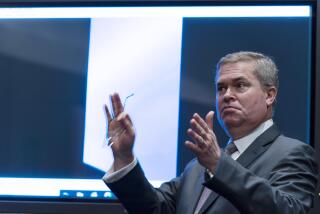Worth Further Inspection
- Share via
A 10-ton machine that the Federal Aviation Administration says can sniff out explosives being smuggled aboard airliners in suitcases sounds too good to be true. It may well be. So a congressional hearing is scheduled for late this month to find out why, under the circumstances, the agency has ordered this country’s airlines to buy and install enough of the 10-ton machines at 40 of the busiest airports in the United States and abroad to examine all luggage being checked into cargo holds.
Rep. Cardiss Collins (D-Ill.) called the hearings for Sept. 25 and 26 before her government activities and transportation subcommittee of the House Government Operation Committee. She and other members will not go into the investigation exactly cold. Commenting on the agency decision to require the explosive detectors, she said her committee has spent months looking at the problem and at test results, and has serious reservations about the move.
The FAA acted in response to an order from Congress last December to tighten up airport security after a smuggled explosive blew a Pan American 747 out of the sky over Lockerbie, Scotland, killing 270 passengers.
Collins said that the FAA decision is premature, partly because the equipment is expensive, has not been thoroughly tested and “has disturbing limitations in its detection of plastic explosives,” the kind suspected of being used on Flight 103.
What the FAA might be doing, she says, is “locking the industry into the wrong technology, providing a false sense of security to the flying public and aborting other technologies” that might work far better if competition to build a better bomb trap were allowed to continue.
In a written critique of the decision, Collins said that the FBI wrote the design specifications that companies had been trying to meet a number of years ago, before intelligence agencies discovered that terrorists were switching from standard to plastic explosives in making their bombs. Even though it has been widely known for at least five years that plastic was increasingly the choice for terrorist bombing, the agency did not change the design standards.
Another difficulty with the kinds of machine that the FAA has ordered into place--devices that use thermal neutron-analysis technology--is that they do not really sniff out bombs; they sniff out concentrations of nitrogen. Often that signals the presence of explosives, but heavy woolens, leather shoes and nylon clothing can exude nitrogen at levels that will make a TNA machine think it has found a bomb.
What that means, among other things, is that inspection by security staff will always be necessary to verify the machine’s findings. During one series of tests, a TNA device rang up two dozen false alarms in the process of filling the cargo hold of one wide-body jetliner. There is no better way than that to create long delays at airports while security officers poke around gingerly inside luggage that may, or may not, be loaded and set to go off at any time.
The FAA calls the TNA technique “the most advanced explosives detection device” now available, but that, in some ways, is beside the point. As one subcommittee staff member noted, even if the TNA devices worked perfectly, there are other holes in the presumed shield of security that is now in place that must be sealed up. Because closing holes in the rest of the shield will take time, there is time to wait for explosive-detecting technology to improve. That means there certainly is enough time for the Collins subcommittee to find out whether the agency’s answers are as good as its questions.
More to Read
Sign up for Essential California
The most important California stories and recommendations in your inbox every morning.
You may occasionally receive promotional content from the Los Angeles Times.













